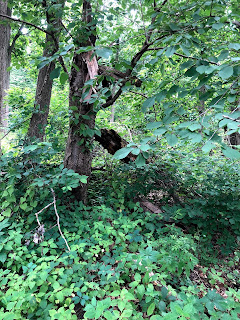Amelanchier arborea
Identification Information
Date: Saturday, June 12, 2021
Time: 5:00 p.m.
Location: Sweet Orr Commons (23 E. 6th Street, Pottstown, PA 19464)
Habitat: Temperate Mixed Forest
Weather conditions: 84 degrees Fahrenheit, slightly humid, some cloud cover
At my niece's apartment, I remember always seeing this berry tree and wondering what it was... perfect opportunity!The leaves are oblong and about 2 inches long. They are toothed and pinnately veined. Berry clusters grow out of leave whorls and look like tiny apples.
The main trunk was about 4 inches across but divided into 4 main branches fairly low. Bark on the trunk and branches was fairly smooth with some fine horizontal ridges.
(Brockman, 1986, p. 172)
This tree might have been 10 feet tall. It is on the edge of the courtyard where it can get plenty of sun.
I stumbled across a couple of interesting tidbits about the name, but I wasn't able to confirm any of them. Most related to them blooming when roads became serviceable or when the ground thawed enough that you could hold funeral services. But I did find a pie recipe or two and a really cool reading of a book based on the Lenape.
































